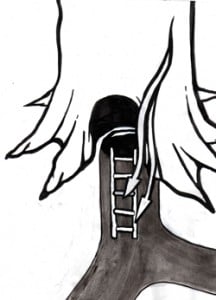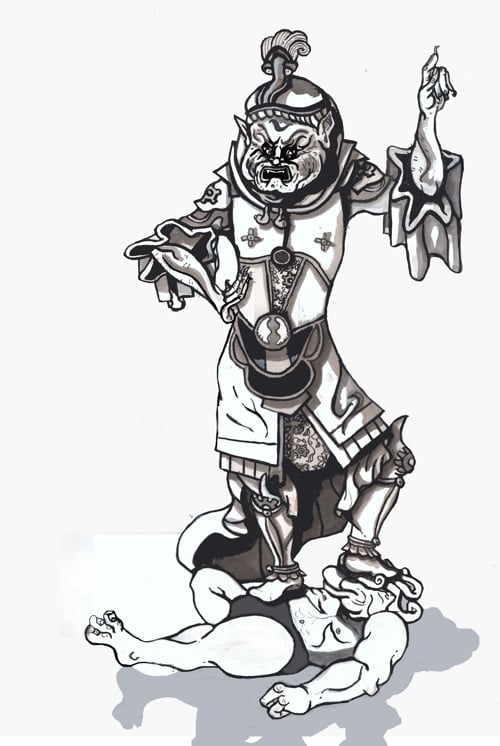Linda (4)
By:
June 23, 2011
HILOBROW is proud to present the fourth installment of Karinne Keithley Syers’s novella and song cycle LINDA, a hollow-earth retirement adventure with illustrations by Rascal Jace Smith. New installments appear every Thursday.

The story so far: Linda, a retired math teacher from Tennessee who also wanders in a double world where she walks in a place called the globe with a dog called dog-Linda, seems to be receiving transmissions via a radio that is connected to her gut, although we don’t exactly know how this works. In the last installment, an incoming transmission made her collapse, and so the dog dragged her into the safe space of the globe, where they just fell asleep on the forest floor.
8.
Linda dreams she is packed in ice.
The dog dreams she is digging.
Resting under ice, Linda sees a series of images: old planet maps, satellite photos with circles and arrows pointing to some kind of gape, maybe a dark lake or a hole in the surface. It’s like having a dream not generated by her own mind. The images flicker in short gusts, as if fed in by pneumatic tube, and then by adjoining her sensation, becoming parasitically her. In the dream, Linda is packed in ice because she is a convict awaiting rehabilitation to society, but is also a secret agent in the guise of a convict, and knows these images playing into her mind are a kind of briefing for a mission she is to carry out beyond the dream itself. The acuity created by this pressure, not just to receive but to be ready to perform, engraves these images with uncommon precision, so much so that she can still see each one, many years later, and describe them vividly to my daughter, who will come to see her in a small house on dirty hill near an inland sea.
In one diagram a series of circles recedes into a central chamber. In another, the land falls away in terraces, like an inverted Macchu Picchu climbing not away from but into the earth. In another a series of encampments rings an unseen source of luminosity. Others slice the earth crossways, showing two almost-semi-circles not quite touching, so as to make openings above and below, like a mouth and anus hovering around an interior empty of anything to consume or digest. There are drawings of calm seas ringed with ice, diagrams of ancient volcanoes plotted through with cross-sets of light beams pointing to a modest opening, a beckoning line of descent. Ringed planets glow in heat-sensitive photographs, with perfect circles at each end white against amber. A weather photograph shows concentric circles etched out of the cloud layer above the south pole. Another diagram in the style of the 16th century shows the earth circumferenced by cities while inside a maze of burrows proceed toward a central sun which is represented by a gilded rabbit with an enflamed heart. Others picture water-filled ice chasms illumined by a green boreal glow. There is a painting of an interior gemstone cathedral, a cavern brushed by massive crystalline spikes, with a brass floor that traces the orbits of the planets in grooved pathways. There is a drawing of an evacuated volcano, thousands of tiny figures descending into it, with blankets and still tinier animals strapped to their backs.
When the images end, Linda replays them carefully in her mind. As she does this, she feels the ice is gone and that her limbs are moving although she is passive, and she believes she is no longer dreaming. Someone’s hands are on her, manipulating her limbs like she was an accident victim relearning how to walk, softly rotating and hinging bone against bone, pressing up into the leg from the heel, flexing her knees and then wrists. Sensation returns to her arm, other arm, leg, other leg. She feels warmth in the curve of her belly where dog-Linda’s skull presses on her gut.
Linda knows she is lying on the floor of the globe, but in flickers she discerns also a room, and a face above her which searches her own face for signs of consciousness. These flickering images hover like a film across the forest she lies in, spectrally super-positioned, now more, now less concrete. The room, when she sees it, is neutral, a group work space in an empty office building, taupe or grey and unremarkable. Fluorescent lights overhead extend in lines behind the head of the woman above her. The room emerges and recedes from her vision, coming into focus for no more than a few seconds before dissipating in the increasing light of the forest, but even when it disappears she feels the woman’s hands on her body continuously. The room jerks into appearance now, strong and humming with electricity. Above her the woman’s face is cold, professional, and Linda cannot decide if this woman impresses or unsettles her. “How do you feel?” asks the woman. Like I’m under icepack, Linda would like to say, like I’m a convict being rehabilitated to society, but Linda can’t make sound, can’t make her tongue move. The woman touches Linda’s mouth, inspects her teeth, moves her jaw, pushes into her temples. She realizes her hands must be cold against Linda’s face, so she rubs them together then replaces them. “Is that better?” she asks. Linda would like to respond but noise doesn’t work so she blinks her eyes vigorously as the hand continues its mandibular inquiry. Linda feels the woman reach into her mouth, feel along her teeth for the back of her mouth, and then quickly slip something into a gap between her molars, which strikes her soft gums harshly, making her bleed. Linda protests noiselessly, eyes blinking wildly and fingers reaching along the side of the woman’s body. Above her the woman removes her hands and watches Linda’s face impassively. Someone else, an assistant maybe, walks into view and leans over Linda, and the woman tells him something, which he notes in a small blue book. Linda tries to hit her knee to push her away, but as she reaches she sees her hand pass through the knee and the vision of the room and the woman is gone.
Above her are trees. Her stomach hurts. There is something in her mouth. Her bleeding gums activate too much saliva, which hits her acidic gut and comes back up. Linda holds her belly. Dog-Linda licks her face but she rolls over, away from the dog, and cries, then stops crying and watches ants on the forest floor carrying a fly, some kind of bluet, into a little tunnel of leaves. Until this moment, thinks Linda, I haven’t protested. I have been good.
My daughter would like to know why I have upset Linda, but I can’t explain it because I do not know. And anyway I do not have a child yet.
9.
I have decided to make a dance for Linda. I decided this last night. The feeling was coming for a while, but I didn’t quite understand how it was “for” Linda, and not for me. I live now a long way from anyone I ever danced with, so I thought I would make a dance for myself to do with the imagined company of my old dancer friends. But last night it suddenly came to me that Linda needed a dance, that after all I am sustaining her by my own dedication to her presence – at least the Linda who walks in the globe and drives in the van – and that she needs my energy as much as my words, and anyway I keep her imagined company. Then I remembered last November standing in the southeast corner of the Freer gallery at the Smithsonian marveling at Japanese statues of the guardians of the four directions, and thinking I wanted them for Linda, as honorary protectors or maybe opponents, obstacles. I remember them as dragons or mythical beasts but I just looked them up, and they’re apparently human looking deities. Anyway, at the Freer I wrote down their names in a small green Chinese accounting notebook: Zocho-ten, Komoku-ten, Tamon-ten, and Jikoku-ten, guardians of the south, west, north and east respectively, and under their names wrote, “standing on eyeballed demons / hips [asway?] – terribleness display.”
I had been thinking of making Linda a serial folk dance, because ever since I gave up thinking of myself particularly as a choreographer, I’ve only had the urge to make folk dances, bopping type dances, or very gentle insignificant dances called Studies of Nothing, which are only there to be erased. But then in the sprung back memory of the four guardian deities I realized that what I would make Linda would be protection dances, like totems or spells for her bad stomach and the demands I’m making of her in this story. So I have decided to make this series of dances, a kind of bestiary set of charm dances for Linda. I have in the past made a good number of tree dances, and so maybe I’ll start there, with the foreshortened curving limbs of the coast live oaks that surround this place I am writing in. Any decent bestiary should include trees, which I’ve always felt were good tutor-counselors if you could just approach them that way, every bit as creature as the rat-walrus my husband saw emerge from and disappear into the rocks in our garden two days ago. I’d like to think that these dances, which express to the cosmos a kind of rooting for Linda and a transfer of power from me to her, can reach the real Linda wherever she is, who is unlikely to ever know I have written this, or that I keep other possible Lindas afloat in my mind, or that every time I’m nauseous I think of her. This morning I burst into tears, I missed dancing with other people so much and it feels so unlikely that all alone I can be capable of forming the experience that is so rare and good it deserves an epithet from Euripides. Anyway, I will try. I have always had an uncommon discipline for making things and hereby summon it to return to me now when I need it most.

And now, listen to the fourth song in the Linda song cycle, The Cornerman Dance Instructional, with apologies to Dimitri Tiompkin and to the Skatalites:
NEXT WEEK: Linda and dog-Linda are taken underground. Stay tuned!
Karinne and HiLobrow thank this project’s Kickstarter backers.
READ our previous serialized novel, James Parker’s The Ballad of Cocky The Fox.
READ MORE original fiction published by HiLobrow.
